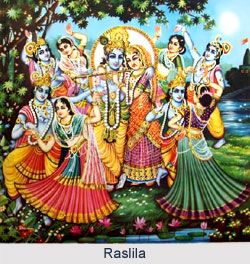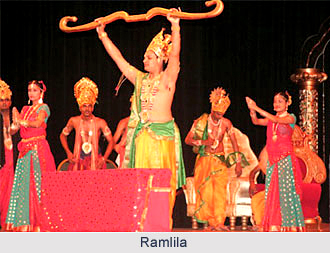 Various types of Ritual theatres that are present, which have their own history and tradition. Some of the names of ritual theatres have been discussed below:
Various types of Ritual theatres that are present, which have their own history and tradition. Some of the names of ritual theatres have been discussed below:
Ankit Nat: The drama that originated from Lord Krishna, in the wake of neo-Vaishnavite movement during the 16th century in the Indian state of Assam is called Ankia Nat. This operatic one act play that depicts the legend of Lord Krishna in all its beauty and grandeur is structurally an attractive synthesis of folk and classical tradition of the region. It was actually developed by renowned Vaishnavite saint of Assam Srimanta Sankardeva during the 15th century and was directed at the illiterate masses of Assam and the tribal population of Bihar and West Bengal. The performance known as Bhaona starts with the approval in Sanskrit Language followed by Eulogy to God in "Brajabuli". It is enacted in four various sequences: playing of "Dhamali", benediction, introduction and the presentation of the "Nat" or story and the moral instruction or "Mukti-Mangal Bhatima". This type of play mainly starts with playing the drum accompanied by big cymbals and small cymbals known as "Khuli Tal", by the musician-singer (Gayen Bayen) in a group. The musical instruments are usually played in various movements in two paces known as "Bar Dhemali" and "Saru Dhemali". Masks happen to be an important ingredient of Bhaona, generally made of bamboo, paper and textile and are also designed to give special facial expressions to many characters.
Among the popular playwrights of Ankit Nat, special mention has to be made about Madhav Deva, Srimanta Sankardeva, Ram Chandra Thakur, Sri Gopal Ata and Dvija Bhusan. The famous mythological plays of Srimanta Sankardeva are "Kalia Daman", "Cinna Yatra", "Patni Prasad", "Rukmini Haran", "Keli-Gopal", "Parijat Haran". Some of the popular plays of Madav Deva are "Chor Dhara", "Ras Jhumura" and "Arjune Bhajana", while those of Sri Gopal Ata are Gopi Udhav Samvad and Janma Yatra.
 Raslila: The Raslila is a special type of dance that is performed by the playful Lord Krishna with beautiful and young girls on the bank of the Yamuna River on a particular full moon night.
Raslila: The Raslila is a special type of dance that is performed by the playful Lord Krishna with beautiful and young girls on the bank of the Yamuna River on a particular full moon night.
Kala: The very word Kala has a particular meaning in the context of myths related to Lord Krishna. In the theatre in ancient India the concept of Kala actually laid the dormant seeds of later Theatres of Krishna that branched out in the form of Gopal Kala, Gaulam Kala and Dashavatar Kala.
Ramlila: Ramlila is nothing but an enactment of the history of Lord Rama, and is performed during the holy festival of Dussehra. The entire Ramayana is actually enacted with the help of songs, dance and dialogues. This is an all-male performance, where, even the character of Sita is enacted by a male actor. This form of ritual theatre is presented in various parts of India, but it is specially popular in Mysore.
Bhuta: The term Bhuta, also known as Bhoota or Kola (meaning spirit), have evolved itself from the primitive and primordial ancestor worship of deified animals and the forces of nature. The spirits are actually supernatural being that manifests itself in a malevolent or benevolent form. Since the time immemorial, the practise of Bhuta worship has been a part of Ancient Indian culture. Presently, it is found in the district of South Kannara, in the Indian State of Karnataka. It can also be associated as a counterpart or corresponding item of "Teyyam" in the state of Kerala.




















